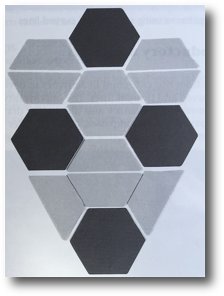Exploring hexagons
Pupils draw three identical regular hexagons.
Hexagon 1: Make two identical shapes with one straight cut.
Hexagon 2: Make three identical shapes with three straight cuts.
Hexagon 3: Make six identical shapes with three straight cuts.

Name the eleven shapes cut out.
Ask pupils to find as many ways as they can of combining some of the eleven shapes to make a hexagon. Decide whether rotations and reflections should be allowed.
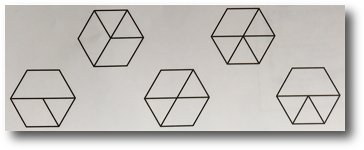
Use all eleven shapes to make a rhombus.
Use nine shapes to make an equilateral triangle.
Parallel lines
Pupils draw parallel lines on two sheets of tracing paper, spread out randomly across the sheets. The pupils explore the shapes and patterns which can be made when one sheet is rotated on top of the other.
Parallelograms on a geoboard
Pupils use a sixteen-pin geoboard. They make as many different parallelograms as they can and record them using spotty paper.
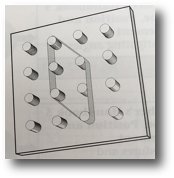
- Pupils investigate the number of pins on the edge and in the centre of the different parallelograms, looking for any patterns.
- They choose one of the parallelograms and investigate how many different positions it can occupy on the board.
The activity can be developed by exploring trapezia on a geoboard.
Symmetry designs
Pupils draw regular polygons, then draw designs on the shapes. The lines of symmetry can be drawn in as a guideline for the designs.
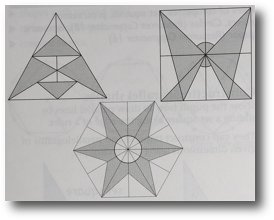
For development:
Make designs which have rotational symmetry. Tessellate the designs:
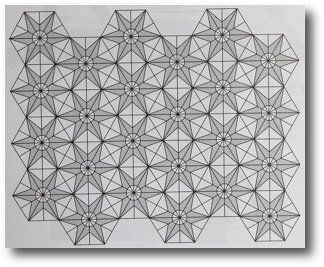
Polygon tessellations
Each group needs a set of 2D shapes. Ask pupils to make two piles of shapes, those which tessellate and those which do not.
Focus on the shapes which do tessellate and ask pupils to sort these shapes.
Which quadrilaterals tessellate?
Which pentagons tessellate?
Which concave shapes tessellate?
Focus on the shapes which do not tessellate and discuss these.
Are there any triangles in this set?
Are there any quadrilaterals in this set?
Are there any shapes here which surprise you?
Technical drawing
Discuss with pupils the need for accuracy in some drawings, and the importance of a sharp pencil!Provide a range of small boxes for pupils to measure and draw accurately. Ask for three drawings: a plan, a side view and a front view. Pupils can select the instruments they want to use from a range including rulers, pairs of compasses, protractors and set squares.
Develop the activity by getting pupils to choose items from the classroom to measure and draw.
Accurate triangles
Discuss with pupils the information eneded to construct accurate triangles:3 sides (SSS)
2 angles and a corresponding side (ASA)
2 sides and the included angle (SAS).
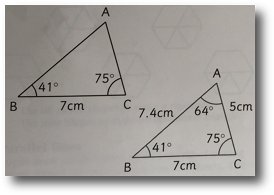
Discuss impossible triangles:
Why is it not possible to construct a triangle with sides 9 cm, 5 cm and 3 cm?
Circles
Discuss the names of the different parts of a circle.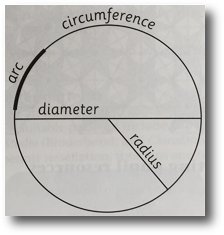
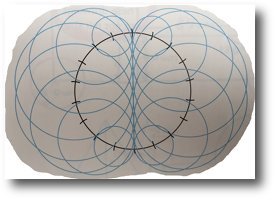
Circle shapes
Pupils use circles with 12 dots (like a clockface) and join the dots with straight lines to construct:· Different hexagons
· Shapes with parallel sides
· Right-angled shapes
· Concave shapes
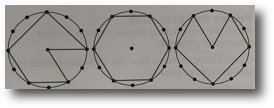
Isometric drawings
Pupils use Isometric paper to draw objects and shapes, drawing along the lines only:
This can be developed by asking pupils to draw cube models in different orientations:
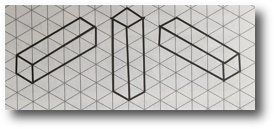
Paper shapes
Pupils each use a sheet of paper and some scissors. They make each of the shapes illustrated by folding and cutting, without using a ruler, protractor or pencil.
Explosions
Pupils draw round a shape tile on to coloured paper and cut it out.
They cut in to the shape in different ways and fold back the pieces to create a pattern.
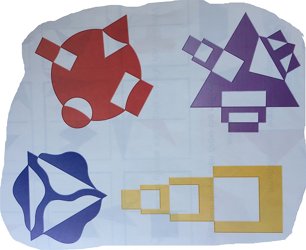
Reflected cut outs
Pupils use two different colours of paper. They cut the same shapes out of each piece to make a reflected picture like this one.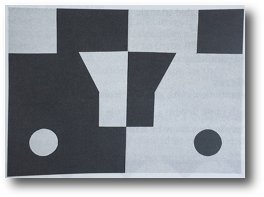
Behind the wall
Use large shape tiles or card cut-outs of 2D shapes. Hide them behind a large book or box and slowly reveal them one at a time for the children to recognise and name. If there are enough tiles each child could have a selection to hold up to match the hidden shape.
Guess the shape
The pupils sit in pairs in a circle back to back. A selection of 15 or more 3D shapes is collected in the centre of the circle. One of the shapes is chosen by a pupil from each pair and described to their partner. It is then returned with all the other shapes for the partner to find and name. The pairs then swap roles. The game can also be played with 2D shapes.
Draw my shape
Make a number of regular and irregular card shapes. In pairs, one pupil describes a shape to their partner without showing it to them. They must draw the shape as accurately as they can from the instructions. The drawing and shape are then compared for accuracy.
Flipping shapes
Pupils choose a shape tile and make a sequence by flipping the shape over and over again to make a simple frieze. This can be done in several ways:
· Drawing round the shape on strips of plain paper
· Drawing a shape on strips of squared paper and continuing the flip sequence
· Using tracing paper to draw the flip sequence.

Extend the activity to include flipping the shape horizontally and diagonally as well as vertically.
Reflections
Pupils work in pairs. They each draw a shape and a mirror line on squared paper. Their partner draws the reflection. Encourage them to draw the mirror lines in different positions, such as horizontally or diagonally.
Square cuts
Organisation: whole class or groups
Pupils need two identical squares of card, one of which they cut along a diagonal.

Challenge pupils to arrange their three shapes to make:
· A right-angles triangle
· A rectangle
· A trapezium
· A parallelogram
More square cuts
Organisation: whole class or groups
Pupils need a square of card. They mark the mid-point of one side, join it to a corner and cut out the two pieces.
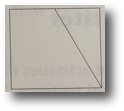
Challenge pupils to rearrange these two pieces to make as many different shapes as they can. Make the rule that only equal sides may be placed side by side.
At least seven different shapes can be made. Pupils should record each shape they make and write some facts about it.

Isometric grids
Organisation: whole class or groups
Pupils draw a simple shape on isometric paper. They then draw the same shape but in different orientations. Tracing paper can be helpful.
Extend the activity to drawing the reflections of shapes.
Friezes
Organisation: class, groups or individuals
Each pupil designs a simple tile on a 3 x 3 grid.
They make a frieze by reflecting, rotating or sliding their design.

Pupils should be encouraged to try different designs until they find one which looks pleasing to them. The friezes can be displayed around the room.
Pattern display
Each group creates a display of manufactured patterns to be added to a class display.· These patterns can include: wall paper samples, fabrics, clothing, covers, tins, wrapping paper, ...
· Encourage pupils to categorize their patterns in some way: two-colour patterns, wavy lines, checked, ...
· Use language labels on the display.
· Pupils choose a pattern and copy it using crayons, printing, computer graphics, ...
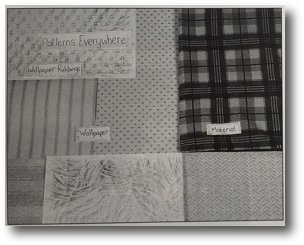
Multicultural patterns
Different cultures use patterns and design in different ways and for different reasons.Pupils can collect and copy some of these.
Possibilities include:
- Rangoli floor patterns are a well-known artistic tradition in India. In some parts of India they are called Alpana. Rangoli patterns can be done freehand inside a square, circle or rectangle on square dotted paper.

- Add food colouring to sand and make Rangoli patterns by trickling different coloured sands through an inverted paper cone which has a small hole at the point.
- Suitable colouring can be applied to hands (or card cut outs) to make Mehendi patterns. A different pattern can be made on each finger.
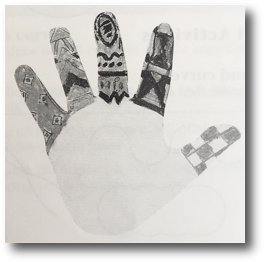
- Surahi, or ghara, are pitchers which are often decorated. Pupils can decorate pictures of such pitchers.
- Garlands such as Genda, Bela and Gulab often play an important part in festivals and celebrations. Making simple garland patterns involves pupils in making cyclic patterns.
- Eid greetings cards often have symmetrical patterns on them. Pupils can design their own greetings card for a special occasion.
Environmental patterns
Pupils collect example of patterns they find in the environment. These can include: brick patterns, tiling, wrought iron designs, company logos, ...The examples can be copied by rubbings, freehand sketches, photographs, ...
Natural patterns
Pupils look for and make collections of natural patterns. These patterns can include: cobwebs, flower heads, leaf patterns, pebbles, feathers, ... Mosaic patterns
Mosaic patterns can be linked to Roman, Greek, Islamic, ... mosaics. Pupils can design their own mosaic patterns from a variety of materials: gummed paper, pasta pieces, beads, flower petals, ...In Derbyshire there is a village tradition of well dressing. Beautiful mosaic pictures and designs are made from natural materials such as flower petals, moss, twigs, seeds, ... These are pressed into a bed of clay to create the picture which is then displayed at the head of the village well as a thanksgiving.
Stained glass windows
Pupils design their own stained glass window effect using black card and coloured tissue paper. Emphasise the need for pattern and design. Gap patterns
Pupils choose a shape tile and fit lots of that shape together to leave gaps. All the gaps should be the same size and the same shape.Extend it to use two shapes to make gap patterns and investigate the different shaped gaps that can be made.
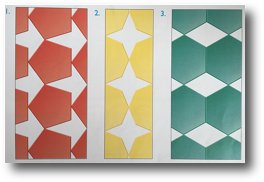
Symmetrical fractions
Pupils copy this grid onto squared paper. 
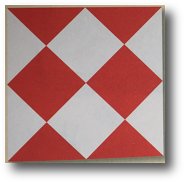
Extend the activity by asking the pupils to choose a different fraction to make symmetrical patterns.
Make a tile
Organisation: whole class or groupsPupils make a tile from a square and an equilateral triangle and tessellate with it.
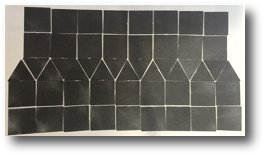
Gaps or no gaps?
Each group needs a set of 2D shapes. Ask pupils to make two piles of shapes, those which tessellate and those which do not.· Explain that tessellation means covering without leaving gaps.
· Focus on the shapes that do tessellate and ask pupils to sort these shapes.
Which four-sided shapes tessellate?
Which curved shapes tessellate?
· Focus on the shapes that do not tessellate and discuss them.
Are there any triangles in this set?
Are there any shapes here which surprise you?
Rectangle pattern
Pupils need a set of rectangles or a rectangle template. Ask them to make as many different tessellating patterns as they can using their rectangles. 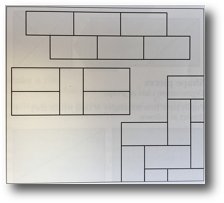
Tessellation display
Pupils create a display area of tessellations they have found or made. This can include wall paper samples, fabrics, clothing, drawings, newspaper pictures, ...
Dissections
Organisation: class or groupsPupils cut up a shape into two or three pieces and rearrange the pieces to make new shapes.
Each new shape should be described as accurately as possible with the help of a glossary.
Possible dissections include:
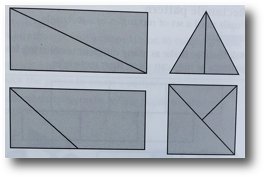
Shape pieces
Organisation: class or groupsPupils have four rectangles of card which they dissect as follows:
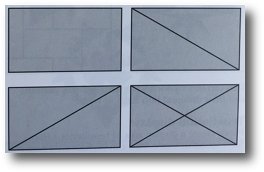
Tessellating tiles
Organisation: groupsPupils use tessellating tiles to make patterns. Many sets of such tiles include curved shapes and unusual 2D shapes such as concave shapes.
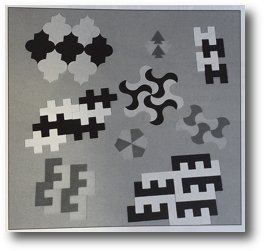
Two-tile patterns
Organisation: groupsPupils choose two different shapes and make tessellating patterns from them.
